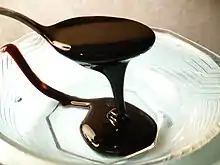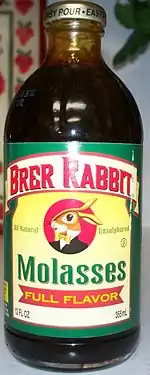Molasses
Molasses (/məˈlæsɪz, moʊ-/)[1] is a viscous substance, principally obtained from the refining of sugarcane, or sugar beet juice into sugar. Molasses varies in the amount of sugar, the method of extraction and the age of the plant. Sugarcane molasses is usually used to sweeten and flavour foods. Molasses is a major constituent of fine commercial brown sugar.[2] It is also one of the main ingredients used to distill rum.[3]

Etymology
The word molasses comes from melaço in Portuguese,[4] a derivative (intensifier) of mel (honey)[5][6] with Latinate roots.[4] Cognates include Ancient Greek μέλι (méli) (honey), Latin mel, Spanish melaza (molasses), Romanian miere or melasă, and French mélasse (molasses).
Cane molasses

Cane molasses is an ingredient used in baking and cooking.[7] It was popular in the Americas before the 20th century, when it was plentiful and commonly used as a sweetener in foods[8] and an ingredient in brewing beer in the colonies. George Washington had a notebook that contains a molasses beer recipe.[9]
To produce molasses, sugar cane is harvested and stripped of leaves. Its juice is then extracted, usually by cutting, crushing or mashing. The juice is boiled to produce a concentrate and encourage sugar crystallization. The result of this first boiling is called first syrup ('A' Molasses) and has the highest sugar content. First syrup is usually referred to in the Southern United States as cane syrup rather than molasses. Second molasses ('B' Molasses) is produced by a second boiling and sugar extraction and has a slightly bitter taste.
Boiling the sugar syrup a third time yields dark, viscous blackstrap molasses ('C' Molasses), known for its robust flavour. During this process, the majority of sucrose from the original juice is crystallized and removed.
Unlike highly refined sugars, molasses contains significant amounts of vitamin B6 and minerals, including calcium, magnesium, iron and manganese; one tablespoon provides up to 20% of the recommended daily value of each of those nutrients. Blackstrap is also a good source of potassium.[10]
The bitterness of blackstrap molasses is much greater than in the regular form of molasses. It is sometimes used in baking or to produce ethanol, as an ingredient in cattle feed, or as a fertilizer.
Exaggerated health benefits claimed for blackstrap molasses were the theme of the 1951 novelty song Black Strap Molasses, recorded by Groucho Marx, Jimmy Durante, Jane Wyman and Danny Kaye.[11]
Madeira Island
In Madeira Island cane molasses is a big part of the traditional cuisine, where it is known as mel-de-cana (Portuguese for "sugarcane honey").[12] Its origin in Madeira dates back to the golden age of sugar production in the archipelago.[13][14][15][16]
Sugar beet molasses
Beet molasses is 50% sugar by dry weight, predominantly sucrose, but contains significant amounts of glucose and fructose. Beet molasses is limited in biotin (vitamin H or B7) for cell growth and hence may be supplemented with a biotin source. The non-sugar content includes many salts, including calcium, potassium, oxalate and chloride. It contains betaine and the trisaccharide raffinose. These result from the concentration of the original plant material or other chemicals in processing and are unpalatable to humans. It is therefore mainly used as an animal feed additive (known as molassed sugar beet feed) or a fermentation feedstock.[17]
Additional sugar can also be extracted from beet molasses in a process known as desugarization. The process employs industrial-scale chromatography to separate sucrose from non-sugar components. The technique is economically viable in trade-protected areas, where the price of sugar is supported above market price. As such, it is practised in the U.S.[18] and parts of Europe. Sugar beet molasses is widely consumed in Europe (for example Germany, where it is known as Zuckerrübensirup).[19] Molasses is also used in yeast production.[20]
Other types
Sweet sorghum syrup is colloquially called sorghum molasses in the southern United States.[21][22]
Pomegranate molasses is a traditional ingredient in Middle Eastern cooking. It is made by simmering a mixture of pomegranate juice, sugar and lemon juice and reducing the mixture for about an hour until the consistency of syrup is achieved.[23]
Unsulfured molasses
Many types of molasses on the market are branded unsulfured. In the past, many foods, including molasses, were treated with a sulfur dioxide preservative, helping to kill off moulds and bacteria. Sulfur dioxide is also used as a bleaching agent to help lighten the colour of molasses. Most brands have abandoned the use of sulfur dioxide in molasses because untreated molasses already has a relatively stable natural shelf life. Poor flavour and the trace toxicity of low doses of sulfur dioxide are also factors that have led to its removal.[24]
Nutrition
| Nutritional value per 100 g (3.5 oz) | |
|---|---|
| Energy | 1,213 kJ (290 kcal) |
74.73 g | |
| Sugars | 74.72 g |
| Dietary fiber | 0 g |
0.1 g | |
0 g | |
| Vitamins | Quantity %DV† |
| Thiamine (B1) | 4% 0.041 mg |
| Riboflavin (B2) | 0% 0.002 mg |
| Niacin (B3) | 6% 0.93 mg |
| Pantothenic acid (B5) | 16% 0.804 mg |
| Vitamin B6 | 52% 0.67 mg |
| Choline | 3% 13.3 mg |
| Minerals | Quantity %DV† |
| Calcium | 21% 205 mg |
| Iron | 36% 4.72 mg |
| Magnesium | 68% 242 mg |
| Manganese | 73% 1.53 mg |
| Phosphorus | 4% 31 mg |
| Potassium | 31% 1464 mg |
| Sodium | 2% 37 mg |
| Zinc | 3% 0.29 mg |
| Other constituents | Quantity |
| Water | 21.9 g |
| |
| †Percentages are roughly approximated using US recommendations for adults. Source: USDA FoodData Central | |
Molasses is composed of 22% water, 75% carbohydrates and very small amounts (0.1%) of fat (table). It contains no protein. In a reference amount of 100 grams, molasses is a rich source (20% or more of the Daily Value, DV) of vitamin B6 and several dietary minerals, including manganese, magnesium, iron, potassium and calcium (table).
The sugars in molasses are sucrose (29% of total carbohydrates), glucose (12%) and fructose (13%) (data from USDA nutrition table).
Other uses
Food products and additives
The uses of molasses in food production may include:
- Principal ingredient in the distillation of rum
- Production of dark rye bread
- Production of gingerbread (particularly in the Americas)
- Production of barbecue sauces
- Some brown sugar is made by combining molasses with white sugar
- In some beer styles of stouts and porters
- Stabilization of emulsifiers in home-made vinaigrette[25]
- Additive in mu'assel (also known as shisha), the tobacco smoked in a hookah[26][27]
Industrial
- As a minor component of mortar for brickwork[28]
- Mixed with gelatin glue and glycerine in casting composition ink rollers on early printing presses[29]
Horticultural
- As a soil additive to promote microbial activity, resulting in increased production of succinic acid, malic acid, butyric acid and mannitol. Production of these common plant defensive chemicals by microbes is believed to aid in suppressing plant disease.[30][31]
See also
References
- Wells, John C. (2008). Longman Pronunciation Dictionary (3rd ed.). Longman. ISBN 978-1-4058-8118-0.
- The Codex Alimentarius Commission. (2009; 2010). Codex Alimentarius – 212.1 Scope and Description. Food and Agriculture Organization of the United Nations.
- "Rum | liquor". Encyclopedia Britannica. Archived from the original on 2017-12-29. Retrieved 2021-02-23.
- "Molasses". Online Etymology Dictionary, Douglas Harper, Inc. 2020. Archived from the original on 10 March 2021. Retrieved 4 November 2020.
- “melaço Archived 2021-09-15 at the Wayback Machine” Dicionário Priberam da Língua Portuguesa
- “O uso de s, ss, c ou ç Archived 2021-09-15 at the Wayback Machine” Ciberdúvidas
- "Cooking with Molasses – Brer Rabbit Molasses Recipes – Easy Baking Recipes". Brer Rabbit. Archived from the original on 2014-04-24.
- Hudson, Jeff (28 January 1998). "Molasses' Bittersweet History". SF Gate. Archived from the original on 2017-09-21. Retrieved 10 March 2021.
- Grasse, Steven (6 September 2016). "A brief history of colonial-era beer (including an awesome Stock Ale recipe)". Craft Brewing Business. Archived from the original on 17 March 2020. Retrieved 17 March 2020.
- Tukua, Deborah. "These Health Benefits of Blackstrap Molasses May Surprise You". Farmers' Armanac. Archived from the original on 2021-11-07. Retrieved 2021-11-07.
- Fleck, H. C. (1968). Toward Better Teaching of Home Economics. Macmillan. p. 195. ISBN 9780023382901. Archived from the original on 2017-12-06.
- "Mel de Cana". www.visitmadeira.pt. Archived from the original on 2022-02-16. Retrieved 2022-02-16.
- Alfred W. Crosby (2015). Ecological Imperialism, The Biological Expansion of Europe, 900–1900 (2 ed.). Cambridge University Press. p. 77. ISBN 978-1-107-56987-4. Archived from the original on 6 January 2020. Retrieved 25 September 2017.
- "The 'White Gold' Era". www.visitmadeira.pt. Archived from the original on 2021-10-03. Retrieved 2021-10-02.
- davide. "Madeira Ruled the Sugar Trade". Archived from the original on 2021-11-11. Retrieved 2021-11-11.
- Ponting, Clive (2000). World history: a new perspective. London: Chatto & Windus. p. 482. ISBN 0-7011-6834-X.
- Lardy, Greg; Schafer, Rebecca. "Feeding Sugar Beet Byproducts to Cattle". North Dakota State University. Archived from the original on 19 January 2022. Retrieved 6 March 2022.
- "Chromatographic Separator Optimization" Archived 2006-08-26 at the Wayback Machine
- "Zuckerrübensirup Translation". Dict.Cc English-German Dictionary. Archived from the original on 4 August 2020. Retrieved 1 November 2019.
- "Bakers Yeast Production and Characteristics" (PDF). Lallemand Baking Update. 3 (4). Archived (PDF) from the original on 6 March 2022. Retrieved 6 March 2022.
- Rapuano, Rina (September 12, 2012). "Sorghum Travels From The South To The Mainstream". npr.org. Archived from the original on May 23, 2014. Retrieved May 22, 2014.
- Bitzer, Morris (2002). "Sweet Sorghum for Syrup" (PDF). N.p.: University of Kentucky. Archived (PDF) from the original on 23 May 2014. Retrieved 22 May 2014.
- Ismayilova, Laman. "Narsharab, country's delicious pomegranate sauce". AzerNews. Archived from the original on 6 March 2022. Retrieved 6 March 2022.
- T, Eric (October 8, 2012). "Why Does my Molasses say Unsulphured? Was Sulphur Removed From it?". Culinary Lore. Archived from the original on September 18, 2015. Retrieved 10 March 2021.
- "Make-Ahead Vinaigrette". Cook's Illustrated. Archived from the original on 2017-09-21. Retrieved 2017-09-20.
- Chaouachi, K (2009). "Hookah (Shisha, Narghile) Smoking and Environmental Tobacco Smoke (ETS). A Critical Review of the Relevant Literature and the Public Health Consequences". International Journal of Environmental Research and Public Health. 6 (2): 798–843. doi:10.3390/ijerph6020798. PMC 2672364. PMID 19440416.
Mixing tobacco with molasses is a very ancient habit. A WHO report dates back "the addition of molasses to burley tobacco in the nineteenth century to create 'American' blended tobacco". [E]arly health-oriented anthropological research on hookah smoking showed that it [...] can be traced back [to] the 17th century.
- White, Katie (17 July 2017). "The Hidden Chemicals in Hookah Tobacco Smoke". San Diego State University. Archived from the original on 28 April 2021. Retrieved 10 March 2021.
Hookah users inhale smoke, which is generated by heating hookah tobacco that is fermented with molasses and fruits and combined with burning charcoal.
- Heath, Arthur Henry (1893). A Manual on Lime and Cement, Their Treatment and Use in Construction. Mackaye Press. Archived from the original on 2016-03-06. Retrieved 2015-10-24.
- "Some observations on home-made composition rollers". Archived from the original on 2021-06-25. Retrieved 2023-06-15.
- Rosskopf, Erin; Di Gioia, Francesco; Hong, Jason C.; Pisani, Cristina; Kokalis-Burelle, Nancy (2020-08-25). "Organic Amendments for Pathogen and Nematode Control". Annual Review of Phytopathology. Annual Reviews. 58 (1): 277–311. doi:10.1146/annurev-phyto-080516-035608. ISSN 0066-4286. PMID 32853099. S2CID 221360634.
- "Bioactive materials for sustainable soil management" (PDF). bfa.com.au. Archived from the original (PDF) on 2011-02-27.
External links
 Media related to Molasses at Wikimedia Commons
Media related to Molasses at Wikimedia Commons
